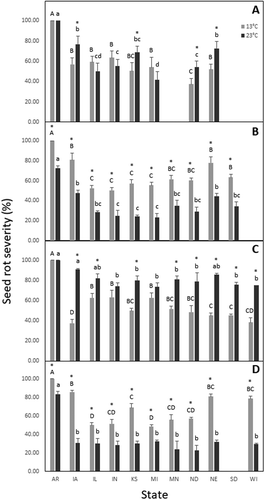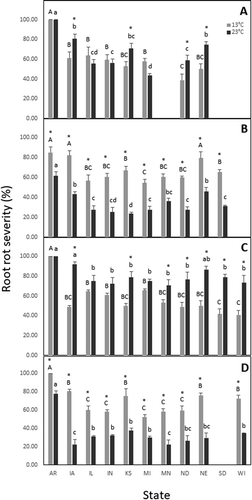Figures & data
Table 1. Number of Pythium isolates recovered from symptomatic soybean seedlings collected in 11 states of the United States of America and evaluated for aggressiveness and fungicide sensitivity at 13°C and 23°Ca.
Fig. 1 Aggressiveness, as a percentage of seed/root rot severity, of four Pythium spp. collected from 11 states of the United States of America and tested on soybean cultivar, ‘Sloan’, using a seed assay. Isolates of Pythium lutarium (A), P. oopapillum (B), P. sylvaticum (C), and P. torulosum (D) incubated at 13°C and 23°C. Columns showing capitalized letters or lower-case letters indicate the level of significance across states for isolates incubated at 13°C or 23°C, respectively. Values followed by the same letter are not significantly different according to Tukey’s Honestly Significant Difference (HSD) test (α = 0.05). Columns denoting an asterisk (*) indicate significant difference between 13°C and 23°C per state

Fig. 2 Aggressiveness, as a percentage of root rot severity, of four Pythium spp. collected from 11 states of the United States of America and tested on soybean cultivar, ‘Sloan’, using a seedling assay. Isolates of Pythium lutarium (A), P. oopapillum (B), P. sylvaticum (C), and P. torulosum (D) incubated at 13°C and 23°C. Columns showing capitalized letters or lower-case letters indicate the level of significance across states for isolates incubated at 13°C or 23°C, respectively. Values followed by the same letter are not significantly different according to Tukey’s Honestly Significant Difference (HSD) test (α = 0.05). Columns with an asterisk (*) indicate greater aggressiveness (P < 0.05) for either 13°C and 23°C for each state

Table 2. Fungicide sensitivity, reported as EC50 values (µg mL−1) ± SE (Range), of four Pythium spp. to metalaxyl and azoxystrobin across 11 states of the United States of America at 13°C and 23°Ca.
Table 3. Fungicide sensitivity, reported as EC50 values (µg mL−1) ± SE (Range), of four Pythium spp. to ethaboxam, captan, and thiram across 11 states of the United States of America at 13°C and 23°Ca
